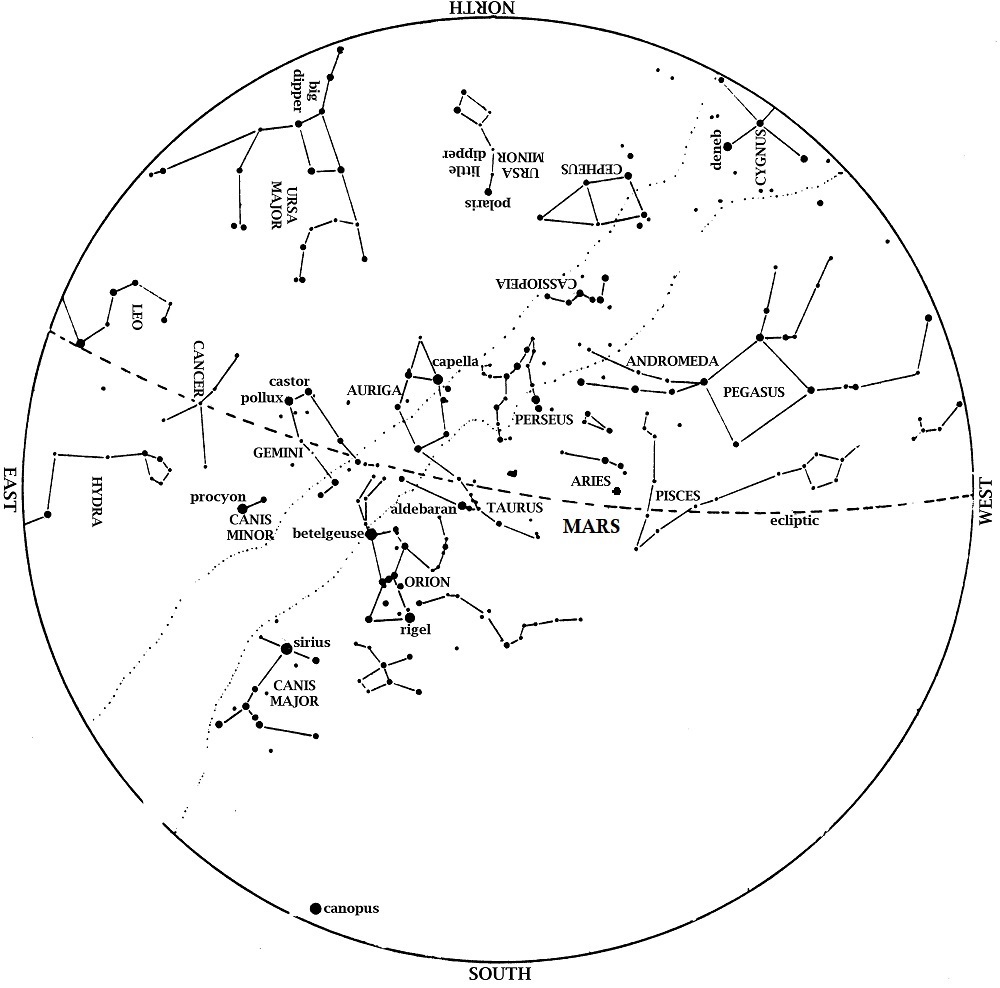Mercury makes a rare appearance in the southwest at dusk. Pick a site with a clear southwestern horizon, and look right above the point of sunset. You can watch Mercury pass Saturn (on the 9th) and Jupiter (on the 10th and 11th) as it enters the evening sky. It returns to the Sun’s glare by the end of the month.

NASA/Johns Hopkins University Applied Physics Laboratory/Carnegie Institution of Washington
Jupiter and Saturn drop out of sight this month; their great conjunction is over. You must observe Mercury’s conjunctions with them in twilight. After that, both giants become lost in the Sun’s glare. Saturn is directly behind the Sun (i.e. in conjunction) on January 23; Jupiter on January 28.
Mars continues to fade a little bit each night now that Earth has overtaken it and is pulling away. However, it fades out gradually; Mars remains much brighter than normal as 2021 begins. And Mars is high in the south–well placed for observing right as night falls.
Venus is still barely visible in the east at dawn, just above the horizon. It gets lower and lower each morning until it, too, is hard to see.
Watch for the Great Square of Pegasus in the west at dusk. Taurus, the Bull is high in the south. Look for the Pleiades star cluster above reddish Aldebaran. Dazzling Orion, the Hunter takes center stage on winter evenings. Surrounding Orion are the brilliant stars of winter. Orion’s belt points down to Sirius, the Dog Star, which outshines all other stars we ever see at night. The Little Dog Star, Procyon, rises with Sirius and is level with Orion’s shoulder as they swing towards the south. To the upper left of Orion’s shoulder is Gemini, the Twins.

The Great Square of Pegasus sets in the western sky. Mars is high in the southwestern sky. Taurus, the Bull, is almost overhead. Dazzling Orion, the Hunter is high in the southeast, with his two dogs behind him. Sirius, the Big Dog Star, is the brightest star we ever see at night. Leo, the Lion, rises in the east. In the north, the Big Dipper gradually re-enters the evening sky.
Moon Phases in January 2021:
Last Quarter Jan. 6, 3:37 a.m.
New Jan. 12, 11:00 p.m.
1st Quarter Jan. 20, 3:02 p.m.
Full Jan. 28, 1:16 p.m.
At 2:59 am on Saturday, January 2, the Earth was as close to the Sun as it will ever get this year; it reached perihelion. So why is it cooler now than in summer? That’s because Earth’s orbit is almost, but not quite, a perfect circle. The Earth-Sun distance varies only by about three percent, which is just not enough of a difference to make us warmer when we come closer to the Sun. The Earth’s tilt on its axis, not its changing distance from the Sun, causes the seasons.
The latest sunrise of the year (7:17 am) occurs on January 10. That’s due to the same effect I mentioned last month; Earth’s slight acceleration near perihelion makes sunrise, noon, and sunset all occur a little later each day. Most of us sleep through sunrise but are awake for sunset, so you’ve probably noticed that sunsets are significantly later than last month. However, the days aren’t really that much longer, as sunrises have been getting later as well. Although the midday Sun is a little higher in the sky now than on the solstice, the difference is still small. After mid-month, when the Sun starts taking a much more noticeably higher, longer path across the sky each day, we’ll start seeing earlier sunrises and later sunsets as days lengthen.
Our George Observatory remains closed. We are preparing ways to operate safely in light of COVID-19 and making the last renovation to our newest exhibits, and hope to open by Spring Break 2021!
Clear Skies!

